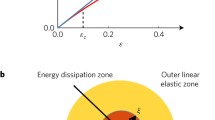Summary
Cracks that are subjected to a sudden, sufficiently large, increase in stress respond with a combination of opening and unstable growth. This behavior is idealized here by representing the opening and growth as two generalized coordinates and determining the corresponding Lagrangean. Then the equation of motion are established for an arbitrary time-dependent driving pressure. Lagrange's equations are especially appropriate for systems involving dissipation, nonholonomic constraints, and other such processes that can not be accounted for in a Hamiltonian formulation. It is shown that the standard results for crack opening and stability are consequences of the Lagrange formulation, as is an algebraic expression for crack speed. Of course, the solution for the crack dynamics is approximate, but solving the full PDEs for the unstable cracks in a brittle structure (∼10,000 cracks/cc) is not practical, nor would it be appropriate since the details of the cracks vary between samples. Thus, the Lagrange formulation makes it possible to analyze brittle materials containing an ensemble of cracks in an efficient manner. In an example the ODEs are integrated numerically and it is shown that the results are consistent with analytic results. In that work the surface energy is considered constant, but when the stresses are modest, crack growth is governed by creep processes. It is shown that this slow growth can be accounted for by letting the surface energy depend on the stress-intensity factor in a manner that is based on crack-speed data.
Similar content being viewed by others
References
Griffith, A. A.: The phenomena of rupture and flow in solids. Philos. Trans. Royal Soc. Lond. A221, pp. 163–167 (1921).
Freund, L. B.: Dynamic Fracture Mechanics. Cambridge University Press 1990.
Zhurkov, S. N., Kuksenko, V. S.: The micromechanics of polymer fracture. Int. J. Fracture2 (4), pp. 629–639 (1975).
Dienes, J. K.: Strain-Softening via SCRAM, Los Alamos Report LA-UR-98-3804, 1998.
Fermi, E.: Taylor instability of an incompressible fluid, Los Alamos Report LA-1927; Collected Papers,2 (244), 1956.
Miles, J. W., Dienes, J. K.: Taylor instability in a viscous fluid. Phys. Fluids9 (12), p. 2518–2519 (1966).
Dienes, J. K.: Method of generalized coordinates and an application to Rayleigh-Taylor instability, Phys. Fluids21 (5), pp. 736–744 (1978).
Sack, R. A.: Extension of Griffith's theory of rupture to three dimensions; Proc. Phys. Soc.58, 729–736 (1946).
Sneddon, I. N.: Fourier Transforms. New York: McGraw-Hill, 1951, p. 498.
Dienes, J. K.: Theory of deformation. Part II, Physical theory, Appendix A: On the relations between internally and externally loaded cracked elastic bodies, LA-11063-MS,10, (2), 251–259 (1989).
Sneddon, I. N.: Fourier Transforms. New York: McGraw-Hill, 1951, p. 60.
Prudnikov, A. P., Brychkov, Yu. A., Marichev, O. I.: Integrals and Series. Gordon and Breach, vol. I, 1986.
Fabrikant, V. I.: Applications of potential theory in mechanics. Dordrecht: Kluwer Academic Publishers (1989).
Stroh, A. N.: A theory of the fracture of metals. In: Advances in Physics, vol. III, 1957.
Charles, R. J.: Dynamic fatigue of glass. JAP29, (12) 1652–1657 (1958).
Evans, A. G.: Slow crack growth in brittle materials under dynamic loading conditions. Int. J. Fracture10, (2), 251–259 (1974).
Dienes, J. K.: A unified theory of flow, hot spots, and fragmentation, with an application to explosive sensitivity. In High Pressure Shock Compression of Solids II (L. Davison, D. E. Grady, M. Shahinpoor, eds.) Springer, 1996, pp. 366–398.
Mulford, R. N., Sheffield, S. A., Alcon, R. A.: Initiation of preshocked high explosives PBX 9404. PBX 9502, PBX 9501, monitored with in-material magnetic gauging. 10th Int. Detonation Symposium, Boston, MA, 12–16 July, pp. 459–467, 1993.
Author information
Authors and Affiliations
Rights and permissions
About this article
Cite this article
Dienes, J.K. Crack dynamics via Lagrange's equations and generalized coordinates. Acta Mechanica 148, 79–92 (2001). https://doi.org/10.1007/BF01183670
Received:
Revised:
Issue Date:
DOI: https://doi.org/10.1007/BF01183670



